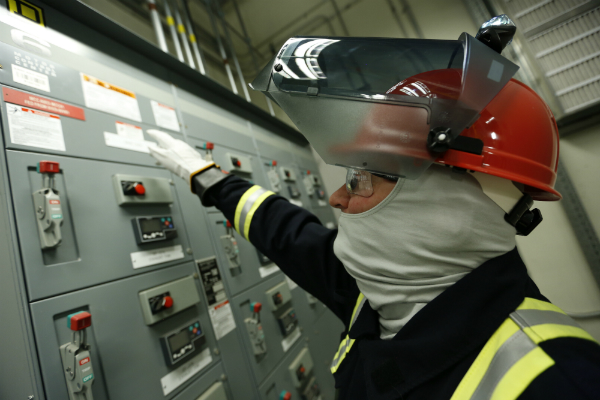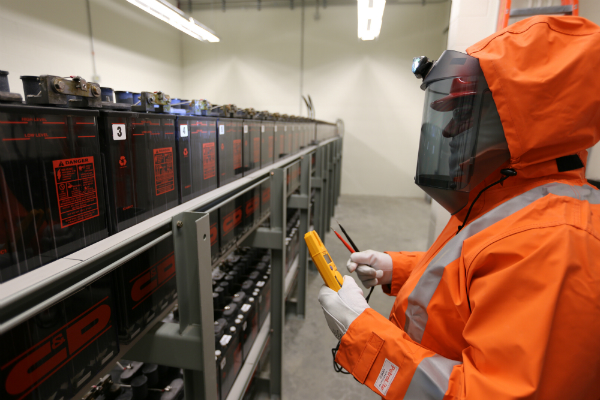
Articles
COVID-19 Updates
Features
Safety
Safety News
Tools and Equipment
Warnings
Sharing is not caring… when it comes to arc flash PPE
March 27, 2020 | By Jim Pollard
Workers who share PPE are at higher risk of being exposed to the virus that causes COVID-19.
 Photo: Jim Pollard and Oberon Co.
Photo: Jim Pollard and Oberon Co. For decades, workers have been sharing arc flash personal protective equipment, including suits, hoods and face shields but—to protect the safety and health of our workers—this age-old practice must stop immediately.
Workers who share PPE are at a higher risk of being exposed to the virus that causes COVID-19. In this regard, sharing is not caring. Actually caring about our workers requires employers to issue individually assigned equipment. Any PPE, tools or equipment that must be shared among workers must first be cleaned and disinfected before each use.
Sharing versus individually issued
The best way to protect workers from cross-contamination is to stop sharing arc flash PPE. Suit hoods and face shields are particularly high-risk due to their proximity to the worker’s mouth and nose. Every time you exhale, cough or sneeze, your bodily fluids can be deposited onto the interior surface of the shield and/or fabric.
Even outerwear garments, such as suit coats, can become contaminated when workers dutifully and conscientiously cough or sneeze into their arm. The safest solution is to individually assign all arc flash PPE, and prohibiting workers from sharing any PPE that cannot be effectively cleaned and disinfected before each use.
Cleaning versus disinfecting
In all situations where PPE, tools and equipment are used by workers, employers must ensure all surfaces that can be touched have been cleaned and disinfected. However, cleaning is not the same as disinfecting. The Centers for Disease Control & Prevention (CDC) define cleaning versus disinfecting as follows:
Cleaning refers to the removal of germs, dirt, and impurities from surfaces. Cleaning does not kill germs, but by removing them, it lowers their numbers and the risk of spreading infection.
Disinfecting refers to using chemicals to kill germs on surfaces. This process does not necessarily clean dirty surfaces or remove germs, but by killing germs on a surface after cleaning, it can further lower the risk of spreading infection.
Can the virus survive on arc flash PPE?
Current evidence suggests the COVID-19 virus can survive on arc flash PPE and remain viable for hours, up to days. The World Health Organization (WHO) provides additional guidance:
It is not certain how long the virus that causes COVID-19 survives on surfaces, but it seems to behave like other coronaviruses. Studies suggest that coronaviruses (including preliminary information on the COVID-19 virus) may persist on surfaces for a few hours or up to several days. This may vary under different conditions (e.g. type of surface, temperature or humidity of the environment).

Photo: Jim Pollard and Oberon Co.
Can arc flash PPE be disinfected?
There are both porous and non-porous surfaces with which we should be concerned. Equipment should be cleaned first, before it can be disinfected. Hard, non-porous surfaces such as arc flash face shields, suit hood shield windows, hard hats and other plastic components can be disinfected using disinfectant sprays or wipes. Consult with the manufacturer before using any disinfectants, because non-durable surfaces could be damaged.
For porous surfaces such as arc-rated fabrics, proper cleaning can be an effective way to “wash out” the COVID-19 virus from clothing. All arc-rated garments must be removed from service and cleaned as per the manufacturer’s instructions. This process might include fully disassembling arc flash suit hoods to separate the fabric portion from the other hood components. The garments and the hood fabric portion should be washed according to the product labels, and thoroughly dried before its next use.
Home vs. Industrial Laundering
Both Home Laundering and Industrial Laundering services are acceptable. Follow the manufacturer’s instructions and consult with the applicable ASTM Standard to ensure you don’t compromise the protective properties of your equipment; ASTM F2757 for Home Laundering, and ASTM F1449 for Industrial Laundering.
Summary of recommendations
The current global pandemic acutely highlights the necessity to stop sharing arc flash PPE. We are dealing with a sober reality: sharing PPE between workers should be prohibited, unless it can be cleaned and disinfected between uses. The risk of cross-contamination between workers is simply unacceptable.
There is currently no consensus as to how long the COVID-19 virus can remain on arc flash PPE surfaces, either porous or non-porous. For now—and for any future viruses—the safest, most effective way to prevent the spread of infectious diseases and keep our workers healthy is to individually assign arc flash PPE to every worker requiring it. We must all work together to help stem the spread of the virus that causes COVID-19.
An award-winning Electrical Safety Champion, Jim Pollard is focused on thermal personal protective equipment, including arc flash and gas extraction suit technologies. In 2008, he started Unlimited PPE Inc. to provide specialized PPE solutions, and performs as an agent for Oberon Company Arc Flash PPE. Visit unlimitedppe.com.
Editor’s note: This article was originally published on March 23, and was updated on March 27 to reflect changes to the CDC’s website that provide additional guidance and resources on how to launder clothing that is potentially contaminated with the virus that causes COVID-19.
This article—along with other great content—also appears in the May 2020 edition of Electrical Business Magazine.
Print this page